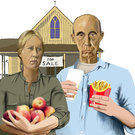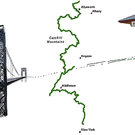Editorial
Some traditions are old hat, others require sacrifice
The story of the first Thanksgiving has taken on a mythic stature for most of us. We learn, from the very youngest age, about the Pilgrims setting sail from England on the Mayflower and landing in Massachusetts in 1620. The brutal first winter in the Plymouth killed many; half of those in the colony died of starvation or disease.
Part of the reason the Puritans survived in the wilderness of the New World was because they were befriended by a Pautuxet Indian named Squanto. He spoke English since, more than a decade before, he had been captured by an English sea captain. He taught the Pilgrims to plant native crops.
The Pilgrims celebrated their survival at a harvest festival in 1621.
Squanto was unusual, of course, because he knew Western culture and language, having been trapped into learning about it. He couldn’t return to his own tribe because it had been wiped out by disease. He died, too, soon after that first Thanksgiving.
What is remarkable is the sharing that went on across the New World from many Native Americans as they first encountered Europeans.
We recently wrote here about Russell Shorto’s book, The Island at the Center of the World, which details the early history of Manhattan an island that the Dutch settled and ran after Henry Hudson’s 1609 voyage.
“We are used to thinking of American beginnings as involving thirteen colonies to thinking of American history as an English root onto which, over time, the cultures of many other nations were grafted to create a new species of society that has become a multiethnic model for progressive societies around the world,” writes Shorto. “But that isn’t true.”
After England took over New Amsterdam in 1664, renaming it New York, its rich, multi-cultural history was lost, writes Shorto; Englishmen, mortal enemies of the Dutch, wrote early American history. “When the time came to memorialize national origins, the English Pilgrims and Puritans of New England provided a better model. The Pilgrims’ story was simpler, less messy, and had fewer pirates and prostitutes to explain away,” he states.
Last week, our holiday section featured an article by Ellen Zunon in which she developed modern menus based on local Iroquois fare from nearly four centuries ago. She was inspired by reading A Journey into Mohawk and Oneida Country, 1634-1635, published by Syracuse University Press.
In 1621, the same year the Pilgrims were celebrating their first Thanksgiving, the West India Company was chartered and given a monopoly of the fur trade in New Netherland; patroonships were set up from the Connecticut River to Delaware Bay. The Dutch supported and traded with the Mohawk while the French were allied with the Huron. The Dutch were worried about the French making inroads to their territory.
And so, in the winter of 1634, Harmen Meyndertsz van den Bogaert, a young barber and surgeon, was sent from Fort Orange to lead two other Dutchmen into the wilderness of the Mohawk Valley to look into the decline of the fur trade and to negotiate new prices for furs.
Van den Bogaert kept a daily journal, detailing his sojourn from Dec. 11, 1634 to Jan. 21, 1635. His journal was translated by Charles T. Gehring and William A. Starna, with linguistic notes by Gunther Michelson.
Zunon points out that every upstate New York schoolchild has learned of the “Three Sisters” corn, beans, and squash the staples of the Iroquois diet. Indeed, Guilderland schoolchildren have planted a Three Sisters garden and eaten their produce. Zunon goes on to explain in detail how, according to the research of Dr. John Hart at the state museum, the cultivation of these three crops in a system known as intercropping, dates from about 1300 A.D. Foods that we cultivate and eat today are based on a New World system that is seven centuries old.
The Native Americans gave our current America more than their food. Our democratic form of government may be based, in part, on native traditions. The translators of van den Bogaert’s journal note that he makes the first separate listing of the five Iroquois tribes and, in the same passage, the earliest known reference to the Iroquois Confederacy, the significance of which, they note, previous translators had missed.
What stunned us, though, in van den Bogaert’s matter-of-fact account was that he was offered food at all. The Dutch trio was traveling in the depth of winter when food is not easy to come by, and sharing with someone else means you have less for yourself.
Van den Bogaert often reported slogging through snow up to his waist, or crossing streams that left him and his companions near frozen.
On just the second day of his journey, still in the pine bush, the young barber and surgeon writes, “We would have then continued on, but I could not move my feet because of the rough going; so we slept there. It was very cold with a north wind.”
Their very survival, time and time again, depended on the generosity of strangers. The Mohawks in the settlements that the Dutchmen come across take them in. Van den Bogaert describes their communal living in the longhouse, and how they share their food, and their blankets of bear and mountain lion with their visitors. They share their rituals and games as they share their homes.
Their generosity cost them dearly.
In the short term, Old World diseases for which the Native Americans had no immunity killed them in large numbers. In the long run, the very basis for the Iroquois society the wilderness on which their hunting and way of life depended was encroached upon by the Europeans.
Van den Bogaert frequently writes about the Indians they visit crowding around them with excitement and curiosity.
He describes sitting on New Year’s Day in an encampment with 46 Indians. “Had they had any malicious intentions,” he writes, “they could have easily grabbed us with their hands and killed us without much trouble.”
In fact, he receives a letter from Fort Orange, concerned that they have been killed.
Far from it. Instead, even after their rations for exchanging gifts had run out, the Dutch explorers were welcomed and provided for.
“The chief gave us many goods and fed us as well,” van den Bogaert wrote on Dec. 21, “for everything in his house was at our disposal. He told me simply that I was his brother and good friend.”
We, as Americans, live now in a time and place of plenty, when sharing does not take much effort nor involve much sacrifice. We can’t turn back the clock to restore a way of life to Native peoples that earlier generations stripped away. But we can learn from those who walked this land before us to share what we most value and make amends as we are able.
Whom do we call brother and good friend? Only those we know, so similar to ourselves? Let us make room at our figurative Thanksgiving table for those who are different, who are strangers in our land. Let us focus on the qualities we share as human beings, and let us be grateful for those, in generations now far removed, who brought us to this place.
Melissa Hale-Spencer, editor

